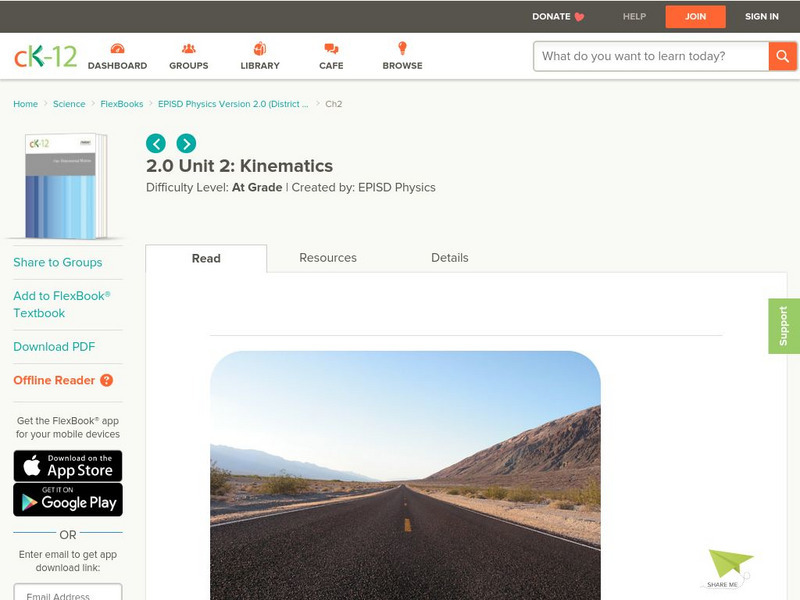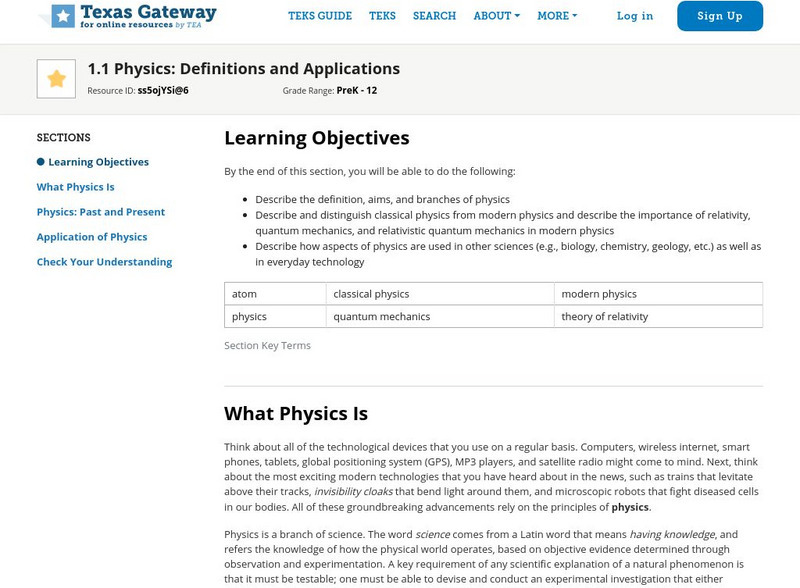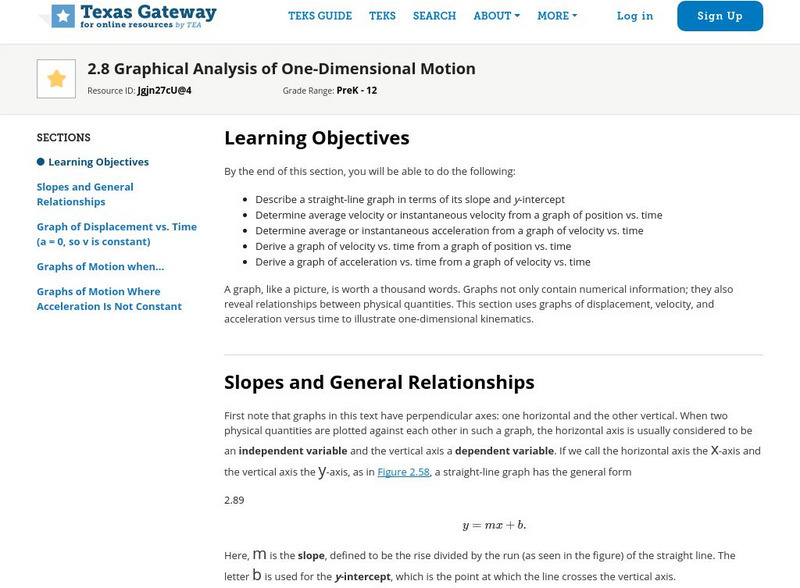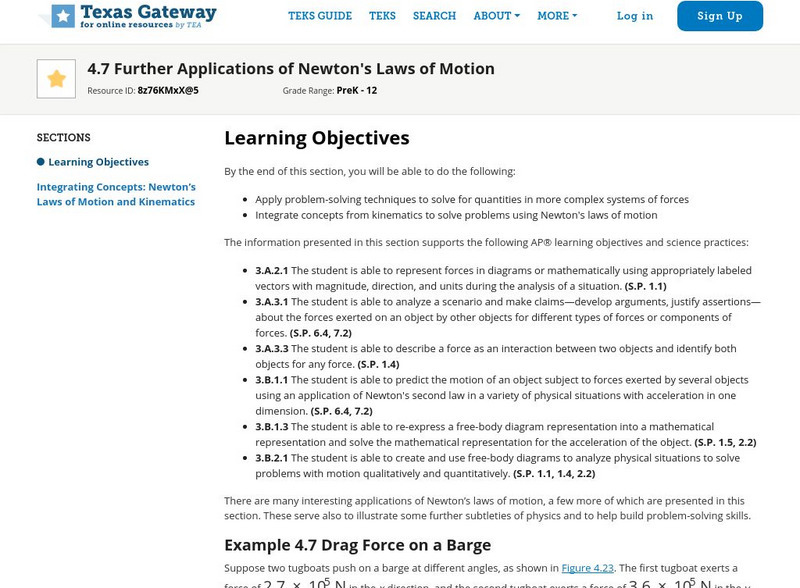College Board
AP Physics 1 and 2 Inquiry-Based Lab Investigations
Have you ever wondered what type of AP Physics investigations The College Board wants? This is the guide for you! Sixteen labs covering both Physics I and II will get you started and inspire you to meet the requirement of 25 percent of...
Texas Education Agency
Texas Gateway: Ap Physics: Kinematics of Rotational Motion
By the end of this section, you will be able to observe the kinematics of rotational motion, derive rotational kinematic equations, and evaluate problem solving strategies for rotational kinematics.
CK-12 Foundation
Ck 12: Episd: Physics: Kinematics
[Free Registration/Login may be required to access all resource tools.] An online chapter focused on motion and the shapes it takes. Topics range from speed and velocity to acceleration and free fall. Find detailed visuals, learning...
Texas Education Agency
Texas Gateway: Kinematics in Two Dimensions: Section Summary
This is a summary of each of the sections in Chapter 3: Kinematics in Two Dimensions of the AP Physics online text.
Texas Education Agency
Texas Gateway: Kinematics in Two Dimensions: Conceptual Questions
This is a list of 21 questions focusing on the major concepts of each section of Chapter 3: Kinematics in Two Dimensions such as adding and subtracting vectors using different methods.
OpenStax
Open Stax: Problem Solving Basics for One Dimensional Kinematics
In this interactive module, students will apply problem-solving steps and strategies to solve problems of one-dimensional kinematics. They will also apply strategies to determine whether or not the result of a problem is reasonable, and...
Texas Education Agency
Texas Gateway: Physics: Definitions and Applications
By the end of this section, you will be able to describe the definition, aims, and branches of physics; describe and distinguish classical physics from modern physics and describe the importance of relativity, quantum mechanics, and...
Texas Education Agency
Texas Gateway: Kinematics in Two Dimensions: Addition of Velocities
By the end of this section, you will be able to apply principles of vector addition to determine relative velocity and explain the significance of the observer in the measurement of velocity.
Khan Academy
Khan Academy: What Are the Kinematic Formulas?
Featured are the kinematic formulas or main equations you can use to analyze situations with constant acceleration.
University of New South Wales (Australia)
University of New South Wales: School of Physics: Physclips: Rotation
Learn about rotational kinetic energy, rotational kinematics, torque, rotational mechanics, and angular momentum in this learning module that includes animations and videos.
Texas Education Agency
Texas Gateway: 2.6 Problem Solving Basics for One Dimensional Kinematics
By the end of this section, you will be able to do the following: Apply and problem-solving steps strategies to solve problems of one-dimensional kinematics and Apply strategies to determine whether or not the result of a problem is...
Texas Education Agency
Texas Gateway: Glossary for Kinematics in Two Dimensions
This is a glossary of terms and definitions used in Chapter 3: Kinematics in Two Dimensions of the AP Physics online text.
Physics Classroom
The Physics Classroom: Describing Motion With Words
This lesson from the Glenbrook South High School gives a nice review and detailed explanation of velocity, speed, distance, displacement, and acceleration. A good introduction to the "language of Kinematics."
OpenStax
Open Stax: Kinematics in Two Dimensions: An Introduction
In this interactive module, students will observe that motion in two dimensions consists of horizontal and vertical components. They will understand the independence of horizontal and vertical vectors in two-dimensional motion.
Texas Education Agency
Texas Gateway: Kinematics in Two Dimensions: Projectile Motion
By the end of this section, you will be able to identify and explain the properties of a projectile, such as acceleration due to gravity, range, maximum height, and trajectory; determine the location and velocity of a projectile at...
Georgia Department of Education
Ga Virtual Learning: Ap Physics 1: One Dimensional Kinematics
Using only two of our fundamental units, time and displacement students will build a framework to predict the motion of objects, starting with one dimensional motion.
Georgia Department of Education
Ga Virtual Learning: Ap Physics 1: Rotational Kinematics and Energy
This module is the introduction to model rotational motion. All of the concepts are conveniently recast into forms that have the same mathematical forms as their translational counterparts.
Texas Education Agency
Texas Gateway: Kinematics: Falling Objects
By the end of this section, you will be able to describe the effects of gravity on objects in motion, describe the motion of objects that are in free fall, and calculate the position and velocity of objects in free fall.
Texas Education Agency
Texas Gateway: Kinematics: Graphical Analysis of One Dimensional Motion
By the end of this section, you will be able to describe a straight-line graph in terms of its slope and y-intercept, determine average velocity or instantaneous velocity from a graph of position vs. time, determine average or...
Texas Education Agency
Texas Gateway: 3.1 Kinematics in Two Dimensions: An Introduction
By the end of this section, you will be able to observe that motion in two dimensions consists of horizontal and vertical components and understand the independence of horizontal and vertical vectors in two-dimensional motion.
Georgia Department of Education
Ga Virtual Learning: Ap Physics 1: Two Dimensional Kinematics
In this interactive tutorial, students are introduced to motion in a second dimension, and model and predict the more complex motion of projectiles.
Texas Education Agency
Texas Gateway: 4.7 Further Applications of Newton's Laws of Motion
By the end of this section, you will be able to apply problem-solving techniques to solve for quantities in more complex systems of forces and to integrate concepts from kinematics to solve problems using Newton's laws of motion.
Georgia Department of Education
Ga Virtual Learning: Linear Motion
A learning module where students gain an understanding of the relationships between the different kinds of motion. Students will be able to explain free-fall motion and use kinematics equations to calculate problems involving falling...
Physics Classroom
The Physics Classroom: 1 D Kinematics: Acceleration of Gravity
The practice problems and illustrated examples in this tutorial help students understand the acceleration of gravity. The 'Value of g' widget the tutorial refers to can be found in the Interactives section (link is in side-bar) under...






















